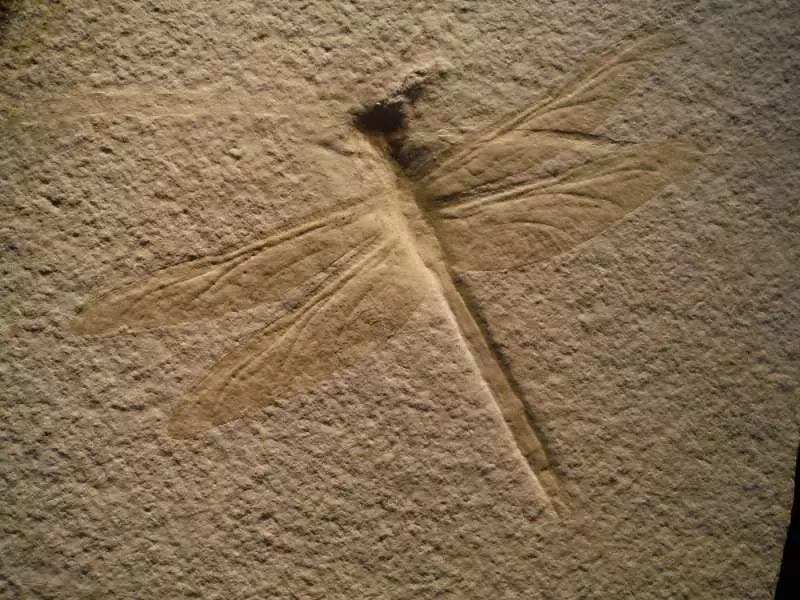During a hot summer day I was doing some yard work at the edge of a wood line on the hill behind my house. Out of the corner of my eye I saw a rapid movement and heard a fluttering sound. Quickly turning, I saw a dragonfly tumble toward the ground. I assumed the dragonfly had nabbed a mid-day meal that proved too heavy to eat-on-the-fly. Getting down on my hands and knees for a closer observation I was surprised to see that a robber-fly was the predator and the dragonfly was the prey. The robber fly was attached securely to the dragonfly’s back with its head above what most people would call the dragonfly’s neck.
Over the next few hours I returned to observe and photograph the series of events.
The robber fly devoured all it wanted of the dragonfly. Then ants swarmed in for their share. Finally, I saw a wasp sitting on the remains. The next time I visited the site there was no trace of the dragonfly; all of this in a matter of about five hours.
This experience motivated me to think about the savagery that exists throughout creation.
Much has been written about the killing and cruelty in the human and animal worlds. Some of the best Christian thinkers have mused about this issue. Perhaps the major argument atheists use to reject God is the blood-letting throughout all living creatures.
I will approach this subject through the realm of insects.
Be forewarned, no one can provide a definitive answer to this mystery because our sovereign God has chosen not to reveal all of His thoughts to us.
WHAT INSECTS ARE (BIBLICALLY)
Arguably the major line of separation between creation and evolutionism, both theologically and scientifically, is the so-called age of the earth. Basically, the issue is how long has life (pretty much as we know it) existed. Without millions of years evolution does not have time to work its magic. Scientifically (mathematically) it does not matter how many years evolution supposedly had. (See the “Lesson Plan”.) Theologically, believing in millions of years means there was death before sin which causes serious problems with a straight forward reading of Genesis. Scientifically, insects (via fossil evidence) are a major road-block to the just-so story of evolutionism because fossil insects are mostly identical to those living today. Theologically, there are some interesting questions to consider.
Just what are “insects” from a Biblical perspective? How do they fit into the Fall of man into sin and the resulting Curse?
Insects are part of the “creeping things” that were created on Day 6 (Gen. 1:25) and God called them “good”. I have no problem with accepting that all originally created insects had a completely beneficial purpose in the pristine creation. Some have argued that “good” does not necessarily mean “perfect” in the sense that insects may have been somewhat bothersome, but not deadly. Another idea is that the Garden of Eden was the only place where there was perfection. In the latter instance, the challenge is to explain how the environment outside the Garden could be balanced since insects reproduce in such large numbers. Also, the question arises of how it could be possible not to have death, in the insect world, since large grazing animals would have accidentally devoured lots of insects. Creationists have proposed solutions to both issues.
To solve the problem arising from reproductive proclivity, it is possible that, before the Fall (likely a very short period of time) the environment was balanced (feeding, digesting, growing, reproducing, and excreting in a controlled rotation). Regarding the death of insects, it could have been that insects do not qualify as living creatures due to their level of consciousness, method of breathing, type of blood, or that they are not normally considered as animals. Obviously, like the heroes of the book of Daniel, insects could have been protected by God supernaturally. Genesis 7:22 suggests animals that do not breathe through nostrils are a special class (not alive). Another approach is from Leviticus 17:11 which states that life is in the blood. But, what qualifies as blood since insects have a type of blood? Also, in Leviticus 11 insects are part of the clean and unclean beasts so one could argue that insects had to be alive to make that list. Scripture leaves room for debate on all of these possibilities.
HOW INSECTS ARE “EVIL”
Gen. 1:30 tells us that the original insects were vegetarian; therefore they would have an impact on the Garden in some way.
In Genesis 2:15 Adam was told to “dress” (Hebrew=work; Dictionary= prepare for use) and “keep” (Hebrew=protect, attend; Dictionary=protect, care) the Garden. This could mean that Adam only had to prune, reap, and maybe modify, arrange and control grazers. Tending the Garden would involve the management of insects.
Many insects scavenge and hunt to get enough nutrients. Right after the Creation event, insects would have been able to obtain plenty of nourishment through vegetation. Granted, some insects seem designed for death–to hunt, trap, attack, and devour. For example, some wasps lay eggs in caterpillars or paralyzed spiders in amazingly complicated ways (See Addendum #14). Keep in mind that the species we see now are what remain after the Curse. By accepting that a lot changed for the worse, and that God knew animals would need to defend themselves, after mankind sinned there are four reasonable possibilities to explain how insects obtained attack and defense structures such as stingers.
1. The structures were designed for something else. Now these are mutated through devolution.
2. The information was there but latent and God, directly or through the environment, switched it on.
3. New information was added supernaturally.
4. Any combination of the first three.
Let’s look at what is the most notorious result of the Fall in the insect world—stingers.
Although there are stingless bees, and male bees and wasps do not sting, some insects (like queens) can sting and lay eggs with the same organ. Evolutionists claim that the stinger evolved from the ovipositor. It takes a lot of creativity for evolutionists to explain how ovipositors evolved to stingers and how the insect survived while the changes were made. Instead of accepting the evolutionist scenario let’s think outside the box. Would it not be easier to evolve from stinger to ovipositor? Or, is it possible the change was really an example of devolution?
Venom is a complicated mixture of enzymes and proteins and its composition is not completely understood. In the beginning venom could have been used to prepare a place (such as a tree limb) to deposit an egg. Also, venom could have been originally used for pre-digestion such as breaking down seed surfaces. Close to the creation event, venom may not have been so irritating to humans. Even today humans can become somewhat resistant to venom. It is interesting to note that bee venom can be used as a treatment for joint pain. The quantity of a chemical is the problem. Some substances are necessary for life, but in excessive amounts they are lethal. For example, too much water can be toxic.
Remember an automobile was designed for good yet, through pollution, accidents, and illegal activities motor vehicles have wrecked havoc upon mankind.
Now, let’s consider the deadliest animal ever to roam the earth—the mosquito. They deliver deadly organisms to millions of people. Female mosquitoes are after iron and protein (to produce eggs) which could have been obtained from plants prior to the Flood. On one hand, if it were not for the itch, a few mosquito “bites” would not be a problem and mosquitoes could once have injected beneficial substances. On the other hand, mosquitoes get infected by biting an infected host, such as a human, so they are not the source of the disease organisms. Medical science is interested in mosquitoes because the insects inject an enzyme to keep blood flowing. Currently, a scientific study of this substance could lead to treating blood clots and preventing strokes. See “Thank God for Insects”.
Related to this subject is the fact that only about 100 of about 2500 mosquito species are a problem. All male mosquitoes (and females for a large part of their lives) are pollinators and get nourishment from plants. From the perspective of creation science it is important to note that the mosquito genes that detect odors (which attract the mosquito to a blood source) are very similar to those in fruit flies. One of the genes that direct a female mosquito to go after blood by reacting to the smell of human sweat is turned off after a blood meal.
Scientists believe they can genetically alter mosquitoes so they are unable to spread disease. Some mosquito species already can block the disease parasite from moving from the intestine to the salivary gland. Before the Fall there could have been a gene to control the parasite. The female has two genes that code for digesting blood. These switch off, and another gene for digesting sugar switches on, when the mosquito is ready to hibernate. There is much about mosquitoes that support the Genesis account of Creation and the Fall.
God created insects for a purpose and, superficially, that purpose may look like insects are made to inflict pain. But, insects are not out to devour us and when we are stung or bitten it is because the insect feels threatened or needs nourishment. Beetle horns appear to be menacing features, but are used for winning a mate and the battles are not fatal. Maggots are used for micro-surgery to care for wounds that the best medical instruments cannot treat. Ant venom has possibilities for the treatment of rheumatoid arthritis. Flies are vital for human health by removing animal wastes, putrid carcasses, and rotting vegetable matter. The correct amount of black flies would just enhance the food chain rather than ruining camping trips.
Of course insects cause many problems with man’s attempts to grow food and flowers, but without insects most plants would not survive and mankind would starve. Many insects widely considered pests have beneficial species. For example, some stink bugs are important as biological control over other insects for a variety of crops. Some of the worst plant pests were transported by men out of their natural habitat. Again, let’s think outside the box regarding insect pests. Usually, plants can compensate for insect damage. Some bark beetles use sophisticated chain receptors to determine if a tree is healthy. Diamond-back moth caterpillars prefer cabbages that are doing poorly. Aphids are plant lice. Perhaps the original purpose of lice was decomposition. Flea larvae eat debris rather than blood. Cotton flea hoppers are harmful to cotton for about one month, but at the peak bloom they are beneficial. We cannot make a blanket statement that insects are “evil”.
The fact is that creation is cursed and man has done things to make things worse. Most insect problems are caused by humans through good intentions, negligence, or evil acts. A volume could be written about the importance of insects including a couple of chapters about the potential benefits of what we often call the “evil things” about insects.
WHY INSECTS MATTER
Atheists claim God is sadistic by creating such tormenting insects like biting bugs and flies. A world renowned skeptic, the late Stephen Jay Gould (See Addendum #14.), felt the ichneumon wasp was the “paramount challenge to God’s benevolence”. The ichneumon wasp bothered Charles Darwin too. Speaking of the ichneumon’s use of a living caterpillar to nourish its developing larva Darwin said, “I cannot persuade myself that a beneficent and omnipotent God would have designedly created the Ichneumonidae…” The argument about why a good God would design attack and defense capabilities is philosophical not scientific.
Even philosophically the matter of insects “bugging” mankind is not a simple matter. Stingers may have been used to provide a harmless reminder to “watch out”. For example, the bombardier beetle spray used to prevent being eaten by accident by a vegetarian. Or it could have been used to attract a mate. Wasps eliminate pain in their prey. If cells are destroyed and the pain is blocked, is their suffering? The question of suffering and pain can lead down some long scientific and philosophical roads.
A tiny percentage of all living creatures experience suffering. There is a survival mechanism in all animals, but a capacity for consciousness must be present for feelings to occur. At the insect level the matter of consciousness may be closer to that of a machine. What humans would call pain may just be a sensation in insects that sends a signal to go to the brain which causes a response. An avoidance response does not equal agony. A highly developed nervous system is needed to experience pain.
There are more insect species that eat animals that are already dead than there are that kill. Without death, animals would use up resources needed for life. Death returns them to the ecosystem. Only a tiny fraction of roach species are considered pests. Roaches are vital recyclers in a healthy ecosystem. Should an individual roach live forever?
The only ones who insist on knowing exactly why and how God did things are atheists. Atheists live in a Fairy Tale Land where they insist on knowing God’s mind. They make themselves gods by claiming God did not do things right. Actually they mean God did not do things the way atheists would have. Amazingly, they claim God does not exist, but if He did exist He would be immoral because He offends the atheist sense of fairness.
Sometimes things are not as they seem. For example, evolutionists claim that butterfly eyespots evolved to help prevent being eaten, but research shows they also are used to attract mates. A 2003 study of rain forest ants (long considered omnivorous) found they mostly live on plant material such as pollen. Our knowledge is extremely limited and, in this life, always will be. “For now we see through a glass, darkly; but then face to face: now I know in part; but then shall I know even as also I am known.” (I Cor. 13:12 KVB)
No one knows what God would have done if the Fall had not occurred. To prevent overcrowding He may have terminated reproduction or He may have allowed us to spread to other parts of the universe. We can have opinions, but these cannot override Scripture.
We cannot attribute human emotions and values to insects. Like the dragonfly’s death that I observed, everything is perfectly designed to function the way the Creator intends. Insects constantly remind us that we live in a sin-cursed world, but the Bible makes it clear that God’s plan for the future will not include stings and bites.
God is in control of all of His creation.







